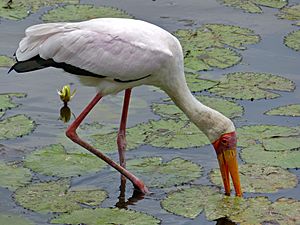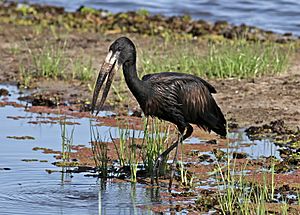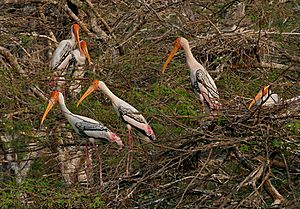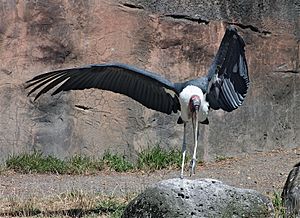Stork facts for kids
Quick facts for kids Storks |
|
|---|---|
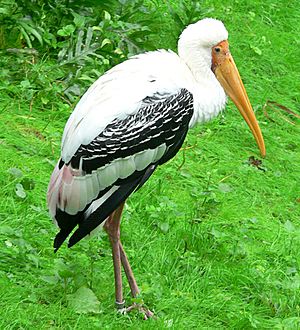 |
|
| Painted Stork | |
| Scientific classification | |
| Kingdom: | |
| Phylum: | |
| Class: | |
| Order: | |
| Family: |
Ciconiidae
Gray, 1840
|
Storks are a group of large birds. They often live near shallow water, like ponds or rivers. They wade in the water to catch small animals such as frogs, crabs, or tiny fish. Many storks travel long distances between summer and winter homes. This is called migration.
There are 19 different kinds of storks, grouped into 6 main types. The Marabou Stork is the biggest stork, while the Abdim's stork is the smallest.
Storks are great at flying high without flapping their wings much. They use warm air currents, called thermals, to glide and save energy.
The White Stork is probably the most famous stork. It builds huge nests in high places, like on chimneys. These nests can be very large and used by the same family for many years.
The Marabou Stork, found in Africa, has a wingspan of up to 320 centimeters (about 10.5 feet). This makes it one of the largest flying birds alive today, along with the Andean Condor.
Contents
What Storks Look Like
Storks are large waterbirds. Their bills are big, and their shape depends on what the stork eats.
Storks can make some sounds, but they don't do it often. They usually communicate by clattering their beaks together.
Where Storks Live
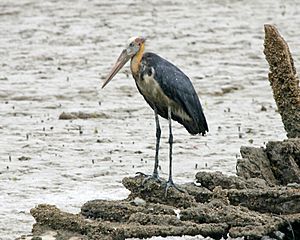
Storks live in many parts of the world, but not near the North or South Poles, most of North America, or large parts of Australia. They are most common in warm, wet places like tropical Asia and Africa.
Just three types of storks live in the Americas: the wood stork, maguari stork, and jabiru. The jabiru is the tallest flying bird in the Americas. Two species, the white stork and black stork, live in Europe and western Asia. The Oriental stork lives in eastern Asia, and the black-necked stork is found in Australia and nearby islands.
Storks are more common in tropical areas where there is plenty of water. Some storks, like the European black stork, live in thick forests. Storm's stork in Southeast Asia prefers rainforests.
Storks that live in cooler areas, like the white stork, black stork, and Oriental stork, fly long distances every year for winter. They choose routes that avoid flying over large bodies of water. For example, storks from Europe often fly across the Strait of Gibraltar or through Turkey and Israel.
Even storks that don't migrate far might move shorter distances if they need to find food or better conditions. Some storks fly daily from their nests to feeding areas. Wood storks have been seen flying up to 130 kilometers (about 80 miles) from their breeding colonies just to find food!
Stork Behavior
How Storks Find Food
Storks are carnivores, meaning they eat meat. They catch many different animals, including reptiles, small mammals, insects, fish, amphibians, and other small creatures without backbones. If they eat any plants, it's usually by accident.
Openbills are special storks that mostly eat freshwater snails, especially apple snails. They often feed in small groups. African openbills have even been seen riding on the backs of hippos while looking for food! After catching a snail, they go back to land or shallow water to eat it.
Stork Reproduction
Many storks build their nests in groups, called colonies, with other waterbirds. These colonies can include other types of storks, herons, egrets, pelicans, cormorants, and ibises. White storks, Oriental storks, and Maguari storks often nest close to each other, but they don't interact much with other stork families. Some storks also choose to nest alone.
Storks in Stories
Storks appear in many old stories. For example, in Aesop's fables from ancient Greece, there are two stories about storks: "The Farmer and the Stork" and "The Fox and the Stork".
In one fable, a farmer sets nets in his field to catch cranes that are eating his seeds. He finds several cranes caught, and also a stork with a broken leg. The stork begs the farmer to let him go, saying he is not a crane. He points to his feathers, which look different from a crane's. But the farmer laughs and says, "I caught you with these robbers, the cranes, so you must share their fate."
A very common legend is that storks deliver babies to their mothers.
Types of Storks
There are nineteen species of stork, including:
- Abdim's stork
- African openbill
- Asian openbill
- Asian Woollyneck
- Black stork
- Black-backed stork
- Greater adjutant
- Jabiru
- Lesser adjutant
- Maguari stork
- Marabou Stork
- Milky stork
- Oriental stork
- Painted stork
- Saddle-billed stork
- Storm's stork
- White stork
- Wood stork
- Yellow-billed stork
See also
 In Spanish: Cicónidos para niños
In Spanish: Cicónidos para niños


